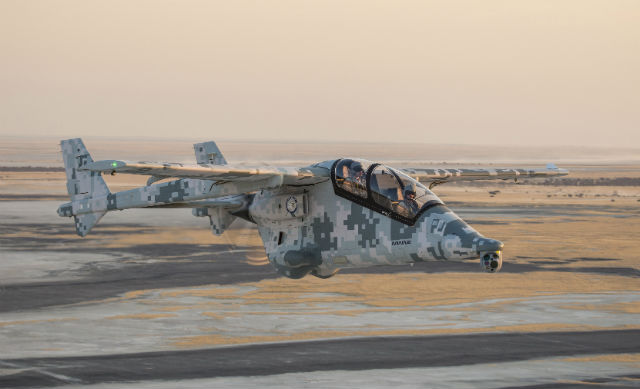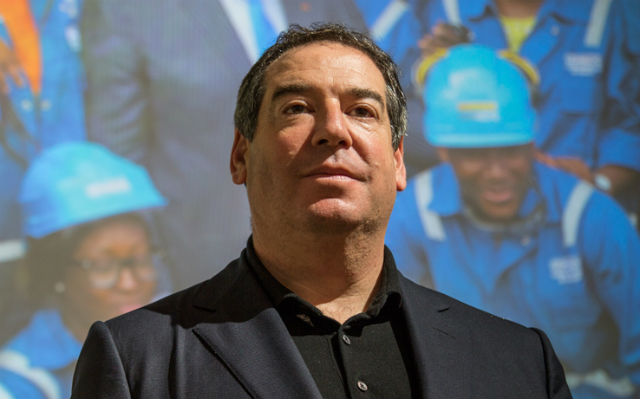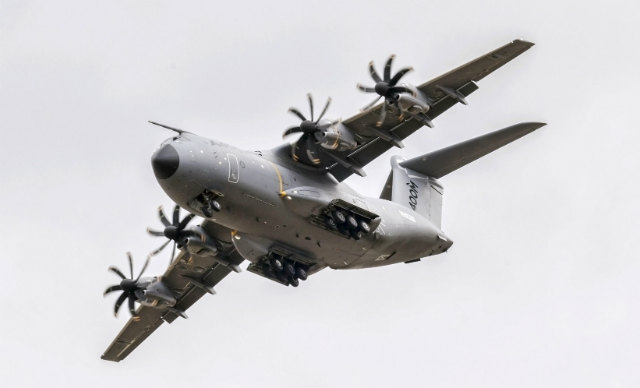In offices overlooking the production hall at AHRLAC Holdings, new graduate engineers work alongside colleagues in their fifties and sixties. The latter are largely veterans of the sanctions-era South African aerospace sector and are mentoring a new generation of aircraft developers.
After what some call two decades of limbo for the industry since the momentous political changes of the mid-1990s, there is new optimism about the prospects for aerospace, embodied in the AHRLAC: a tandem-seat, single-engined, light attack or reconnaissance type currently in flight test. The country’s first post-apartheid indigenous aircraft has been created almost entirely by home-grown talent.

Paramount Group
While AHRLAC – developed by a joint venture led by private defence contractor Paramount Group – is the poster child of South Africa’s potential aerospace renaissance, it is not the only example. After years of fruitlessly seeking an export buyer for the Rooivalk, the attack helicopter Denel developed for the apartheid-era air force, the company has set out plans for a major upgrade, and been authorised by the government to solicit interest from foreign governments. The state-owned entity is also working – albeit slowly – on a concept for a 24-seat commuter airliner, and displayed a fuselage mock-up of the product – dubbed SARA – at September’s Africa Aerospace & Defence (AAD) show.
Meanwhile, Aerosud – another young company part-owned by Paramount – is flying the flag for the civil aerospace sector as a first- and second-tier supplier of aerostructures to Airbus and Boeing. Aerosud’s success is helping reinvigorate a local supply chain of metal shops and other sub-contractors, which had withered in the years since South Africa’s isolated and embattled government of the 1980s was sourcing its defence equipment in-country. In the field of general aviation, another start-up, Vliegmasjien, is developing what it describes as the “first amphibious bush plane”, an idiosyncratically shaped six-seater, single rear-pusher that was also shown at AAD.
A favourite saying of Ivor Ichikowitz, the founder of Paramount Group, is that no country has made the transition from developing to developed economy without a thriving aerospace and defence sector. His boast is that since founding the company in 1994, he has created a prosperous defence and security manufacturer with little help – in terms of finance or orders – from the South African government. Instead, Paramount has slowly established a market in countries which choose not to or are unable to buy US- or European-built equipment, initially in Africa, but increasingly in regions such as central Asia.

Paramount Group
The aluminium-bodied AHRLAC – or advanced high-performance reconnaissance light attack aircraft – is Paramount’s first major aircraft programme. The high-winged, Pratt & Whitney Canada PT6-powered type first flew in July 2014 and has amassed about 230h of flight testing. A second, certification-standard prototype, with a few modifications such as retractable landing gear, is currently in assembly. Although the aircraft has not yet been certificated and no orders have been confirmed, AHRLAC Holdings is demonstrating its confidence in the programme by building a factory at Pretoria’s Wonderboom general aviation airport. It is due to open early next year and will be capable of producing two aircraft per month.
Although Paramount was founded “with the bold goal of helping African governments better protect their countries”, Ichikowitz, one of South Africa’s foremost industrialists and philanthropists, insists that “we have created an aircraft to the highest engineering standards, with the First World as our target”. At AAD, the company unveiled a weaponised version called the Mwari. Ichikowitz says the aircraft – in which the rear crew member sits behind and 55cm higher – will appeal to governments and parapublic agencies in the Indian subcontinent, Europe and even the USA. “We’ve had enough indication of serious interest for us to be taking these markets seriously,” he says.
Despite Paramount’s global ambitions, however, AHRLAC has its roots firmly in Africa. “It draws on the very best we have in South Africa and demonstrates the capability that still exists here,” says Ichikowitz. “A very significant percentage of this aircraft is African.” Although Paramount signed an agreement this year with Boeing to provide a mission system, the company is offering the “open architecture” AHRLAC as ITAR (International Traffic in Arms Regulations) free. The idea is that the Boeing version “will be offered to US-centric markets with Boeing as the prime contractor”, says Ichikowitz. “Markets that don’t want ITAR get a Paramount version.”
While AHRLAC is Paramount’s first home-grown aerial platform, the private company has grown to rival Denel as South Africa’s leading defence contractor. It has achieved this with little largesse from South Africa’s government. Divisions include a thriving armoured vehicles business and a concern it acquired in 2013 and renamed Paramount Advanced Technologies (PAT). PAT specialises in helicopter upgrades – it is currently offering a modernised Mil Mi-17 to countries operating legacy versions of the Russian type – and offers a family of tactical unmanned air systems from the 5kg (11lb), short-range Civet mobile observation platform to the 135kg, 3h endurance Vulture, in service with South Africa.
Paramount also has a significant services arm, offering power-by-the-hour military aircraft support and “Africa’s only ‘Top Gun’ school”: a pilot training academy in Polokwane in the north of the country. Ichikowitz insists there is very little overlap with Denel. “There is a perception that we compete,” he says, “but the two businesses are complementary. Denel are primarily in munitions and major aircraft components. Our business is mainly platforms, rather than sub-systems. We cross over in land systems, but 90% of the time we are not competing.” However, he believes that to prosper, all South Africa’s defence businesses will have to co-operate more.
For Denel, there are pros and cons to being South Africa’s aerospace and defence champion. While it has benefited from government contracts, it also has to operate within the strictures of political oversight. As well as its munitions and land systems activities, the group has two main aerospace divisions: Denel Aviation – concerned mainly with military maintenance, repair and overhaul – and Denel Aerostructures, which designs and builds metal and composite aerostructures for the Airbus Defence & Space A400M, Airbus A350-1000 and the Honda Aircraft HondaJet, as well as being responsible for the potential Rooivalk and SARA programmes.

ImageBroker/REX/Shutterstock
If the aerostructures contracts are Denel Aerostructures’ bread and butter, Rooivalk and SARA are its haute cuisine. After building and delivering just 11 Rooivalks to the South African Air Force, Denel has high hopes of reviving production, this time with a much-revamped variant. The type’s first combat mission since its flight debut more than a quarter of a century ago – a successful attack on M23 rebels in the Democratic Republic of Congo on behalf of the UN’s Force Intervention Brigade in 2013 – has sparked interest from Brazil and the Middle East, says deputy chief executive Victor Xaba.
Now, alongside an initiative to upgrade the existing South African Rooivalks from next year, the government has authorised Denel to solicit interest in a Mk2 version. According to Xaba, everything is in place. “We are still the OEM. There have been significant advances in composites to ensure that we can produce an aircraft that is in line with the manufacturing capabilities of the modern day,” he says. Three designers who worked on the Rooivalk are still with the company – a fragile if vital link to the original programme. The only hurdle is that there are not yet any customers. Xaba says Denel would need orders for 70 to “support re-establishment of manufacturing”.

AirTeamImages
The Rooivalk programme polarises views within South Africa. To its detractors, it has been a grossly expensive white elephant with few export prospects, designed to counter domestic insurgents at a time when these very “terrorists” were preparing to take over the government and armed forces in a peaceful revolution, and soaking up precious funds that could have been spent on schools, housing and hospitals. To its supporters, it was the step-change that gave South Africa a major independent military capability and created a cadre of engineers that helped Denel win its aerostructures contracts and get the start-ups Aerosud and Paramount off the ground.
And so to SARA. The Small African Regional Aircraft is intended to bridge that ageing knowledge to a new generation of aircraft designers, this time in the commercial world. It is more than a study project, says Xaba. Denel believes the concept could end up a flagship programme for South Africa and address a gap in the market, with an affordable Federal Aviation Regulations Part 25 commuter aircraft designed for the African continent. After unveiling an early mock-up at AAD in 2014, Xaba says Denel has funds to build a proof-of-concept example. Taking the project further will depend on funds from government and private investors. “We need to develop gradually,” Xaba admits.
One other by-product of South Africa’s formerly self-contained defence industry is, somewhat paradoxically, the country’s main exporter in commercial aviation. Aerosud Aviation, based in Centurion in Tshwane, and in which Paramount and South Africa’s Industrial Development Corporation own major stakes, was “formed out of the defence world” in 1990, says managing director Johan Steyn. However, it now derives its roughly $72 million turnover from clients such as Airbus, Boeing, Safran and Spirit AeroSystems, providing structural components for the likes of the A320, A350 and A400M, plus Boeing’s 737 and 777. “We’re a 100% export company,” says Steyn.
The business, which employs 660 people, 100 of them engineers or high-skilled professionals, has a wide range of capabilities and technologies, including its own patented composite manufacturing technique and a third party non-destructive testing joint venture. “One of our customers calls us a Swiss army knife. I’m not sure if that’s a compliment or a problem,” notes Steyn. However, Aerosud has also been trying to do less by outsourcing more non-core activities. “Developing suppliers in South Africa is important for us,” says Steyn. “We don’t want to do everything. We are putting a lot of effort into supplier development and we have 10 subcontractors that we mentor.”
South Africa’s location at the foot of a huge continent with few potential customers is a challenge for a small company with little overseas representation. “We’re a long way from anywhere. That gives us a 10% disadvantage over our competitors in terms of costs,” argues Steyn. Another hurdle is the fact that there are “few incentives for aerospace manufacturers”. Ichikowitz agrees that “the government is not doing nearly enough”, but acknowledges that South Africa’s latest Economic Development Plan does finally list aerospace as a primary strategic growth sector.
For Ichikowitz, an active anti-apartheid campaigner in the 1980s, developing new professionals is crucial to the future of South Africa’s industry. “It is one of my biggest focuses. It takes years and years to build that talent pool,” he says. “The apartheid system created two generations of talented engineers and artisans. We have to use these people to train the next generation.”
South Africa in 2016 is not a wholly happy story. Democracy may have changed the lives of millions, but crime, corruption and unemployment remain stubbornly high. Scandal surrounds leading politicians, the rand is ailing and the country’s flag-carrier, South African Airways, appears to be edging towards insolvency. However, the nation is Africa’s most advanced industrial economy and a functioning democracy, with First World infrastructure, schools and universities. Aerospace leaders are convinced their industry is among those that can create high-value careers for thousands of young people and help the country innovate and export its way to greater prosperity.
Source: Flight International


























